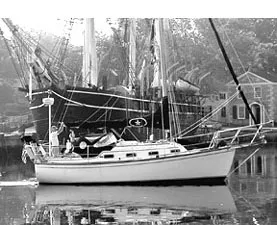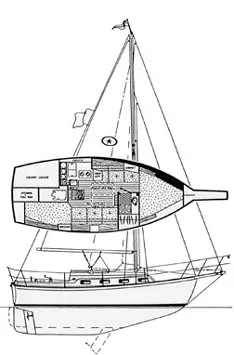More than 20 years ago, backhoes and bulldozers hacked a factory plot out of the mangroves in Largo, FL and Island Packet Yachts was born. The company was started by Bob Johnson, an MIT graduate and naval architect who had worked on missiles for the Navy. In those days there were plenty of “rockets” being built: It was the heyday of the IOR-inspired racer/cruiser. But when Johnson left aerospace he had a different model in mind. Rather than putting bunks in a de-tuned race-winner or sails on a husky trawler, he and his infant company swam against the fin-keeled flow—they created a cruiser built on a modernized version of the traditional long keel.
That boat was stubby, full-transomed, roomy, shoal, and distinctively vanilla. And she was a hit. Suitable for taking across to the Bahamas, gunkholing the Gulf and Keys, and exploring the waterways, she was appreciated first by Floridians. Larger than expected, better-crafted than most small cruisers, and overbuilt in pleasing ways, she came to appeal to a wider world. Priced well above most auxiliaries her size, she nonetheless carved her own niche (29 boats sold in the first two years).
Her success put Island Packet on the map. Introduced in 1980 and originally known as the Island Packet 26, the boat went through a Mark II version before becoming, in 1984, the Island Packet 27. That evolution saw some ballast refinements and interior changes, but those normal tweakings were overshadowed by the fact that sailors in profitable numbers were coming to embrace Johnson’s vision.

As of today, more than 2,000 sailboats have been built at the Largo plant. Current production models are the IP 350, 380, 420, 485, and the Packet Craft 360 powerboat.
Chunky, vanilla-milkshake, bow-spritted auxiliaries dot the anchorages of the world, and several have circumnavigated. IP has prospered while many of the companies (purveyors of fin-keels and full) that once dotted the waterfront have folded.
Johnson and his pioneering people built and sold 249 IP 27s before discontinuing the boat (in favor of the IP 29) in 1992. The chubby little boat with the big long keel started it all.
Today, with a price tag that reflects both the material put into her and the acceptance that she has won, she is not a bargain. Nonetheless, especially when you shop in terms of cubic space, price per pound, and durability, the Island Packet 27 is still an excellent place to look for used boat value.
Design
Johnson has introduced a new boat virtually every year. He has developed and brought to market over a dozen new auxiliaries since starting with the IP 27, but the basic elements haven’t changed very much. He’s won five various “Boat of the Year” awards in the past five years, and those awards would seem to reflect his continuing ability to deliver on the promise of his earliest work, rather than celebrate anything radical in terms of a departure, at least in monohull sailboats.
Johnson’s philosophy as a boatbuilder, and the popularity of his boats, is based largely on his “Full Foil Keel®” concept, which incorporates both modern design techniques and modern marketing ideas.
The merits and demerits of full-length keels have been discussed in these pages before, as well as in other sailing magazines, but we can revisit the general argument here.
Long-keeled boats are made today by only a handful of builders, and Johnson is certainly foremost among them, in terms of boats built and sold. According to one argument, the reason there are fewer full-keeled boats being built today is that modern technology and materials have allowed us to build fin-keeled boats, which are swifter and more efficient—and long-keelers have simply become obsolete.
The long-keel crowd thereupon gets ornery and says, first of all, that relative efficiency depends very much on conditions, and that, in any case, efficiency alone isn’t the point.
The “fin” versus “long” argument may well be fruitless or endless, but if there are any cooler heads left at the end of it we’d hope they might agree: Keels are meant to 1. provide lift, 2. provide righting moment, and 3. offer as little drag as possible. Fin keels do sometimes loosen and fall off. They do lead to pounding and grounding and shallow bilges—but there isn’t much doubt that when it comes to doing all of the essential jobs that keels are meant to do on sailboats, fin keels are runaway victors in any comparison. You get more lift, less drag, and a more effective righting arm, pound for pound, when the keel runs down vertically rather than horizontally.
Cool heads must acknowledge that there are more performance parameters than those dealing only with efficiency. There’s the tendency of a long-keeled boat to be more comfortable in a seaway, and its ability to track straight, easing the helmsman’s burden. A full keel offers housing for a centerboard, which improves performance and achieves shallow draft. (The IP 27 draws just 2′ 8″ with her board up.) Encapsulated ballast doesn’t fall off or out, and a full-keeled boat can be careened on a distant beach for painting or repairs.Finally, there’s the strength of construction that yields a sense of solidity and safety often mentioned by IP owners.
Long keels were fading fast when Johnson introduced the IP 27. Few who gave Johnson’s little cruiser a look failed to come away impressed with her headroom, elbow room, stowage, and general liveability. Most who contemplated going to sea in a boat so small came easily to appreciate the 27’s robust construction, simple systems, efficient layout, and workable sailplan.
Many elements have been a part of Island Packet’s success, but hydrodynamics seem much less a factor to us than build quality, liveability, and detailing. One thing is sure: Johnson’s customers want his boats badly and are willing to pay top dollar for them.
Says IP Director of Sales and Marketing Bill Bolin, “Bob knows all about computers, but he prefers the duck weights and French curves and a blank sheet of paper. IPs aren’t cookie cutter designs, it’s just that the elements that we think make a good boat haven’t changed. Bob believes in U-shaped sections.”
U-shaped sections offer a good trade-off between payload and performance. Starting with the 27 and continuing with her big sisters, Johnson has drawn hull shapes that were spectacularly long on interior volume but somewhat short on hydrodynamic refinement. Deep U-shaped sections afford good payload but when you round out the turn of the bilges you give away form stabilty. Stability is important to cruisers, and Island Packets are stiff boats. For that Johnson relies on abundant ballast. By toting 3,000 pounds of lead around (after 250 pounds were added to the original boat) the 27 earns a quite-effective ballast/displacement of 38 per cent. In his larger boats, Johnson has made the percentage of ballast even greater (and lowered the center of gravity).
When you combine the additions in weight plus the reductions in horsepower (due to a relatively low-aspect rig that minimizes heeling moment), however, you begin to get an idea of the “costs” of stability in terms of liveliness under sail. If you follow the numbers you can see that her 16.7 sail area/displacement ratio signals sailing that’s less than sizzling, and that’s what the majority of her owners report, especially in light air. Take a three-bladed prop, a relatively blunt entry, and wetted surface enough to be very discouraging, and you have further reasons why Island Packet owners tend to reach for the ignition when the breeze gets wispy.
Accommodation
Time and again, owners that we’ve talked to call their boats “the biggest little 27-footer ever.” There’s not much doubt that one of the things to like best about this pocket cruiser is that she expands the cruising envelope for boats of her type. The 27 was followed by the innovative 31, whose tri-cabin set-up made her seem miles bigger than her actual size. Though that approach (quarterberth aft to starboard, big saloon with fold-down table, big galley to port of the companionway, head and closets between the “rooms,” and a jumbo platform double forward) is there with the 27, she offers, in fact, nothing revolutionary. She just makes superlative use of the beam and the height afforded below.
One of the things that helped move Island Packet out of the mangroves and into the main stream was “big boat” joinery. The 27 stands out from other production boats of her era in terms of well-chosen woods, matched grains, mitred corners, pleasing trim.
Builders before Johnson most often made price the principal arbiter in their smaller boats. That’s another area where Island Packet broke away, and it is another key to the company’s success.
The IP 27, like her siblings, exhibits what we’d have to call a certain décor belowdecks. There’s definitely a “designing mind” at work here. One owner even said, “only a woman could have combined comfort, style, ventilation, and roominess with such flair.”
Not that the gender issue should become a sore point, but the upholstery, furniture, and decorative touches are powerful and distinctive. Because Island Packet provides few (originally no) options for upholstery, fabrics, and trim, that powerful and distinctive box is yours to live in. Island Packets all look much alike below. We’re not necessarily at odds with that look—we just wonder what we might do if we were.

There’s plenty of well-planned stowage space: positive catches on the lockers, drawers, and cubbies—shelves with high fiddles. The 27 goes well beyond the “throw-it-below” and “camping out” approaches that long characterized small cruisers. And the quarterberth makes a great sea berth. That is, in fact, what quarterberths are meant to be.
Some owners felt that 30 gallons of water wasn’t enough, and there were others who put in a bid for a larger holding tank. Some said the helm station was too small, but one reported, “We just had a party of 12 aboard for drinks. The people from the bigger boats always seem to come to us.” And there’s the Connecticut owner of a 1985 boat who reported “all the surprises that we’ve had have been pleasant ones.”
From our interviews we’ve found that the people who cruise Island Packet 27s have an extraordinarily high degree of satisfaction with the liveability and comfort provided by their boats.
Construction
Step aboard this 27-footer and there’s no “bobbly” smallboat sensation. At 8,000 pounds she sits solid in the water. The Island Packet 27 displaces as much as 3,000 pounds more than rival auxiliaries of her size and averages about 1,500 pounds heavier than the boats available in her class in 1980. Her big-boat feel and heavyweight status come from the way she’s built. Her long keel may set her apart from the crowd, but rugged construction is another Island Packet hallmark, and it all started here.
The hull is solid, made from a layer of mat and layers of knitted cloth. The forward edge of the keel is built up to almost an inch of solid glass in order to withstand impact. Blistering seems not to have been a big problem with the IP 27s ; of the more than 30 owners we questioned, not one has encountered the pox. An IP 31 owner who was less fortunate, however, told us that grinding blisters away and re-coating the hull was “a relatively simple proposition due to the thickness and quality of the hull laminate.”
Island Packet hulls are reinforced with structural grids. Typical of Johnson’s fusion of the new and the tried-and-true, these precisely engineered structures are built of plywood floor timbers that run athwartships and are glassed to the hull. They are then covered with a fiberglass pan that forms the cabin sole. Used in racing boats, grids let you save weight. Used in high-volume production boats, they help streamline construction. Used at Packet’s “semi-custom” pace and built up in hulls that are hardly weight-sensitive, the grid, as Johnson interprets it, creates an unyielding backbone for the boat. We noted the absence of creaks and flexing, and the bulkheads are built on this solid foundation.
As rugged as the 27 was, she had some problems. Chief among them was cracking in the hull laminate when boats were point-loaded (as in on a jackstand or a reef). Crazing of the gelcoat on the deck was another annoyance with the first boats. The decks are cored (with a factory-developed material still in use after 22 years) and joined (via a solid lip) to an inward-turning flange atop the hull. The joint was bonded with 3M 5200 sealant and clinched with stainless bolts on 6-inch centers. No leaks have been reported to us.
Hardware is attached, as it should be, with aluminum backing plates, and those areas of the deck are solid to avoid crushing the core under load. This system has worked well over the decades, but several owners have reported that they needed to re-bed their chainplates to stop leaks.
Performance
You might expect a boat that is heavy and carries a short rig to be at her worst in light air. The owners of the IP 27 have found that to be true. They gave her a composite rating of “poor” in light-air sailing.
On the other hand, with a long waterline, well-faired hull sections, and a shape with effective sail-carrying power, you might expect the Island Packet to reach well, and you’d be right. One of her larger sisters, an Island Packet 35, won a recent Marion-Bermuda Race by sailing fast with the wind on the beam. “We run away from larger boats,” report many owners. When the wind is free the IP 27 is rewarding. The (optional) cutter rig is at its best in these conditions. With the wind on the beam that additional sail area (via the staysail) can boost boatspeed between 10 and 20 percent.
Sailing upwind is not the 27’s strong suit. Wide sheeting angles are one problem. Lack of “bite” from a low-lift keel is another. Short-tacking the boat (even without the problems of feeding a large genoa through the small space between stays on the cutter rig) isn’t always easy. Upwind the staysail adds windage but hardly any drive. And it’s obviously in the way. “It’s sometimes tricky to get her to sail through a tack,” says one owner. Acceleration is slow, which compounds the lack of lift and inefficient steerage, and usually creates an overabundance of heeling moment. Factor in the relatively blunt entry of the beamy hull and you’re not going upwind fast.
A three-bladed prop and the standard Yanmar 2GMF20 offer a pretty good substitute. “We’re faster under power than Catalina 30s and 36s,” brags one IP skipper. Powering astern isn’t so easy, say several owners. Given her underwater configuration you can see why reversing the IP 27 is more of a challenge than backing down in split-underbody auxiliaries.
“It would have been a good idea to put an access panel in the quarterberth so I could get at the starboard side of the engine,” says a Texas sailor. “I would have appreciated a drain plug on the bottom of the oil pan,” says an owner from Maine.
“If I ever need to work on the fuel pump I’ll have to pull the engine,” adds a third from Chesapeake Bay.
Still, most IP owners have good things to say about their diesels.
Conclusions
Like all used boats, the IP 27 offers experiences to learn from: “Don’t even bother with the c(l)utter rig and get the big (130-percent) genny, not the little (110) one.” “Upgrade the primary winches and make them self-tailing.”
Unlike some owner groups, the Island Packet family is virtually unanimous in praising the factory. Johnson, Bolin, and company they head receive high marks from virtually every angle. Owners repeatedly spoke to us of their hustle, intelligence, fairness, and expertise. The boat that they began with certainly struck a chord.
That resonance had something to do with updating the venerated long keel and making it “fly,” but we think integrity was the key to the success of the IP 27 (and the line that she started). We mean, first of all, the physical integrity of an overbuilt, robust, pounds-per-dollar value; also the “walking the walk” integrity of a boat that can actually cruise far afield at 27 feet, and finally the day-to-day integrity of a company working to make and keep those values real.
Also With This Article
Click here to view “Used Boat Price History.”
Click here to view “Owners’ Comments.”





































Can you beach an IP 27 or 26 with their swing keel like you can a southerly? I need a good shallow water cruiser that doesn’t cost a fortune.
Have you done a review of the Island Packet 29? I cant find a review, and there isn’t much mention on the net. I have an IP29. I would be happy to provide my opinion.
Captain Harry
Captain Harry: I am looking at an IP 29 to purchase. What are your thoughts? How does the cockpit accomodate adults vs. 27 or 31?
Thanks,
GW